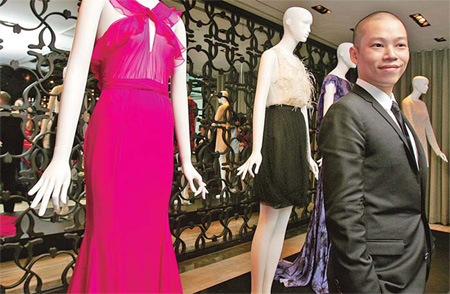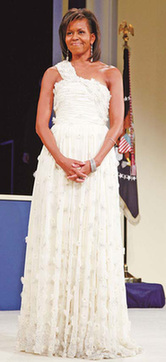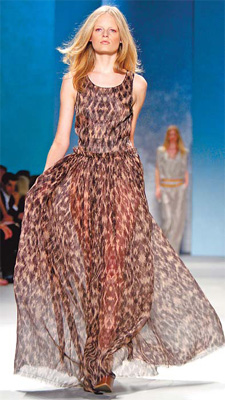Focus
East in vogue as US puts on the style for export
By Kelly Chung Dawson (China Daily)
Updated: 2010-10-29 13:55
 |
Large Medium Small |
Asian-American designers creating lines for Chinese shoppers. Kelly Chung Dawson reports from New York.
If the shows at New York Fashion Week highlighted one trend this year, it was the rise of Asian designers in the United States.
Up-and-comers like Phillip Lim, Thakoon Panichgul and Derek Lam proved hits this summer, which came hot on the heels of Richard Chai, Alexander Wang and Jason Wu being named the best of the new breed by the Council of Fashion Designers of America (CFDA).
 Jason Wu stands in front of his collection at a media event during his homecoming tour on Oct 7 in Taipei, Taiwan. [Photo/Agencies]
|
"Asian designers who are getting more recognition are doing so because they have genuine talent," said Steven Kolb, executive director of the council. "The decision to honor designers with (our awards) is based on talent, and talent alone."
Although ethnicity did not factor in the CFDA awards, fashion experts suggest that rising stars of Asian heritage could have a distinct advantage when it comes to tapping into the growing markets for high-end fashion in the Far East, particularly China.
 Michelle Obama wears the gown designed by Jason Wu during her husband Barack's inauguration as the 44th US president. [Provided to China Daily] |
Major foreign labels are attempting to capitalize on this growth, as well as similar trends across the region, with lines specifically tailored to Asian shoppers.
This year, Levi Strauss & Co released Denizen, a style of jeans targeted at 18 to 28-year-olds in China, South Korea and Singapore, while Hermes launched Shang Xia, clothes specifically designed for Chinese buyers, at its newly opened store in Shanghai.
The region plays an integral part in the plans of most Asian designers, too.
"It is a goal for every designer to be part of China's growing economy," said Prabal Gurung, a Nepalese fashion designer who has enjoyed critical acclaim in the US.
"The Chinese luxury market is becoming more and more important, if not as important as the European market," he said. "You would have to be a fool not to consider China. You would lose out on a lot of business."
Luckily for fashionists with Chinese lineage, they stand to profit from what Simon Collins, Dean of the school of fashion at Parsons The New School for Design, or Parsons for short, believes is a growing sense of national pride in Chinese fashion design.
"It's starting to emerge that Chinese people seem to want to have things be of China," he said.
Going east
As global financial markets have faltered in recent years, Western brands have increasingly been turning to developing markets, such as China and India.
"This change of cultural emphasis has created more opportunities not just for Chinese Americans but Chinese fashion designers as a whole," said Kin Yeung, founder of Blanc de Chine, a Chinese fashion house.
Asian designers who spotted the opportunities are already attempting to expand their markets in the Far East.
 A design of Derek Lam showing at New York Fashion Week. Lam's line is sold at the luxurious Joyce Boutique in Hong Kong. [Provided to China Daily] |
He also recently announced a partnership with Shiseido, the hugely popular Japanese hair care and cosmetics brand.
"I am proud of and grateful for my Chinese heritage," Wu told China Daily. "It seemed like a natural step to expand in the Asian market in a big way."
Derek Lam's clothing is sold in the luxurious Joyce Boutique in Hong Kong, while he also serves as a creative director for Tod's, the Italian shoemaker. Jan Schlottman, chief executive of Derek Lam International, credited both factors with helping the American-born Chinese designer to raise his profile in Asia, especially China.
"With international fashion trends becoming more accessible to Chinese audiences, they've learned to express their personal style through what they wear," said Schlottman. "Within this search we see an opportunity to enter the next generation of brands."
Some fashion observers have questioned whether Asian-American designers targeting China will face problems marketing in a country that has long valued the prestige of European luxury brands manufactured overseas.
However, Collins at Parsons argues that things are changing. "There is a consideration that certain foreign elements have always been more desirable but there is beginning to be a ready openness to embrace Chinese design," he said.
It will be a long time before Chinese brands achieve the same level of prestige as the likes of Louis Vuitton, he said, "but previously those who could afford luxury only desired the credibility of overseas brands, whereas now people are more open".
To attain international prominence, however, Collins suggests Chinese designers avoid branding their companies as strictly Chinese, citing the example of Ports 1961. Although not designed by Chinese, it is a Chinese-owned brand that has remained ethnically ambiguous on the international stage, he said.
Regardless, Schlottman said he believes Lam's Chinese background is a marketing asset.
"As a successful Asian-American fashion designer of Chinese descent, Derek elicits a sense of pride in the Chinese people," he said. "It helps make the brand more approachable in the Chinese market."
Yet, others argue that shoppers are unlikely to buy clothes simply because they were made by Asian designers.
"It's all about good design," said Angel Ho, a Hong Kong-born student at Pratt Institute, another famous New York design school. "If it happens to be an Asian designer, that's cool, (people) will find pride in it. But it's not the main selling point."
Still, the majority of the clothing designed by Lam and Wu is actually manufactured outside of China, partly as a calculated move to avoid the stigma occasionally associated with Chinese manufacturing.
Gurung said that having a "made in New York" line has helped him break into the Asian market.
"There has definitely been more openness to my brand because we're made in the US," he said. "It creates a different story; it gives me a global point of view. It's not that I'm closed to the idea of things being made in China - but for now New York is my base and forms the core of my branding."
These factors may change as Chinese companies race to improve quality, said Schlottman. "A renewed sense of pride can be seen in their work as they become competitive in the international market," he said of the Chinese manufacturers who produce roughly 20 percent of Lam's inventory.
Next generation
Most of the Asian designers now coming under the spotlight are all former students of Parsons, generally regarded as housing one of the best fashion design programs in the US.
According to school statistics, about 70 percent of the program's international students are from Asia. Meanwhile, the Fashion Institute of Technology, also in New York, reports that 23 percent of its 1,200 design students are of Asian descent.
"We can't deny the fact that a great many of the most successful designers in the last 10 years have been Asian," said Parsons' Collins, who with Lam has been asked to judge Creative Sky, a Chinese television design contest similar to Project Runway in the US.
"We don't assess people with any relation to their ethnicity," he continued, "but when someone from (China) becomes internationally famous, it might open the eyes of other people to something they've previously not looked at as an option."
Rebeccah Pailes-Friedman, chairwoman of the Pratt Institute's fashion department, said the number of Asian students who have applied and been accepted to the program has gone up significantly over the last few years.
"There's been a lot of influence of very innovative thinking from Asian designers," she said. "With the economic changes that have been happening in Asia, there's more opportunity for people to have design careers. That economic shift has led to more people wanting to go into design and doing so by searching out an education in the US."
So what has fueled this desire for fashion design among Asian students?
Kolb at the Council of Fashion Designers of America speculates the high numbers of Asian people working in the manufacture of clothes likely contributes to a growing interest in the creative side.
Indeed, Lam has spoken in several interviews about the influence his family's California-based bridal gown import business had on his career. A smaller early wave of Asian designers in the 1980s including Vivienne Tam, Anna Sui and Vera Wang also attributed their development to similar reasons.
"The majority of the Asian designers out there right now are second-generation Americans. Our parents came to the US and traveled the traditional route of becoming doctors, engineers, and architects," added Gurung. "It gave us the opportunity to choose less traditional careers."